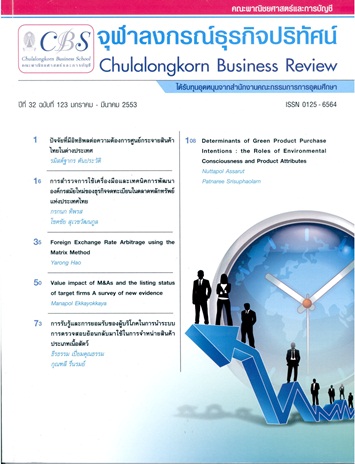Foreign Exchange Rate Arbitrage using the Matrix Method
Main Article Content
Abstract
บทคัดย่อ
บทความนี้ ว่าด้วยการค้นหาโอกาสค้ากำไรในตลาดเงินตราต่างประเทศ วิธีดั้งเดิมที่ใช้ในการบ่งชี้โอกาสค้ากำไรนั้น อาจมีประสิทธิภาพต่ำเมื่อจำนวนสกุลเงินที่เราพิจารณาเพิ่มมากขึ้น ดังนั้น จึงเกิดความจำเป็นที่จะต้องหาวิธีที่มีประสิทธิภาพที่ใช้ในการค้นหาเส้นทางค้ากำไรที่ประกอบไปด้วยสกุลเงินหลายสกุล
หม่า (2004) ได้พัฒนาวิธีเมตริกซ์ที่มีประสิทธิภาพในการค้นหาเส้นทางการค้ากำไรในตลาดที่ประกอบไปด้วยสกุลเงิน N สกุล หม่า ยังได้ค้นพบเงื่อนไขเพียงพอสำหรับการมีอยู่ของโอกาสค้ากำไรด้วย โดยที่งานของหม่า มีพื้นฐานอยู่บนสมมติฐานที่ว่านักค้ากำไรสามารถซื้อและขายเงินตราแต่ละสกุลที่ราคาเดียวกัน อย่างไรก็ตาม ในความเป็นจริง ส่วนต่างราคาเสนอซื้อขายถือเป็นองค์ประกอบสำคัญของค่าใช้จ่ายในการซื้อขายเงินตราต่างประเทศ ดังนั้น เราควรคำนึงถึงส่วนต่างราคาเสนอซื้อขายในขั้นตอนการค้นหาเส้นทางค้ากำไรด้วย
ในบทความนี้ ผู้เขียนปรับเปลี่ยนวิธีเมตริกซ์ของหม่า เพื่อที่จะรองรับกรณีที่ส่วนต่างราคาเสนอซื้อขายไม่เป็นศูนย์ หลังจากนั้น บทความนี้ยังแสดงขั้นตอนการประยุกต์วิธีนี้ โดยมีข้อมูลอัตราแลกเปลี่ยน 65 วันเป็นกรณีตัวอย่าง โดยมีข้อสังเกตว่า เงื่อนไขเพียงพอที่ถูกค้นพบในงานของหม่านั้น ยังคงใช้ได้อยู่แม้กระทั่งในกรณีที่ส่วนต่างราคาเสนอซื้อขายไม่เป็นศูนย์
Abstract
This article focuses on finding arbitrage opportunities in the international foreign exchange market. The traditional methods of distinguishing arbitrage opportunity have low efficiency, and difficulties arise when we face multiple currencies. This poses a need for an efficient method of searching for a multiple-currency arbitrage path.
Ma (2004) has developed a matrix method that efficiently searches for an arbitrage path in an N-currency market. Ma also derives a simple sufficient condition that will guarantee the presence of arbitrage opportunities. Ma’s work is based on the assumption that one can buy or sell each currency at zero bid-ask spread. However, the bid-ask spread represents an important component of the transaction costs, and therefore should be incorporated into the search for arbitrage path.
In this article, the author modifies Ma’s matrix method to accommodate the case where the bid-ask spreads are nonzero. We then illustrate the use of the modified method, using a 65-day series of exchange rate quotes. We also observe that the sufficient condition derived in Ma’s work still holds even for the case of nonzero bid-ask spread.
Article Details
Opinions and discussions in papers published by the Creative Business and Sustainability Journal (CBSJ) are deemed as personal opinions and the responsibility of the writers. They are not the opinions or responsibility of the Chulalongkorn Business School of Chulalongkorn University.
Papers, content, information etc. appearing in the Journal are deemed to be the copyright property of the Chulalongkorn Business School of Chulalongkorn University. Anybody or any organization that wishes to publish any part of them or use them in any way must obtain written permission from the Chulalongkorn Business School, Chulalongkorn University.


